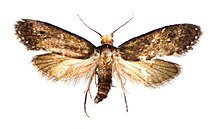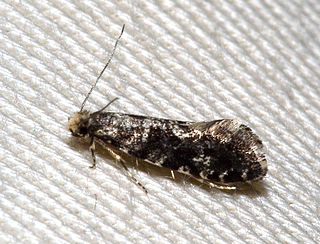
Tineidae is a family of moths in the order Lepidoptera described by Pierre André Latreille in 1810. Collectively, they are known as fungus moths or tineid moths. The family contains considerably more than 3,000 species in more than 300 genera. Most of the tineid moths are small or medium-sized, with wings held roofwise over the body when at rest. They are particularly common in the Palaearctic, but many occur elsewhere, and some are found very widely as introduced species.

Monopis monachella is a moth of the family Tineidae. It is widespread in Eurasia, Africa, India, Sri Lanka, Burma, Sumatra, Java, the Philippines, Taiwan, Japan, New Guinea, Samoa, North America and South America.
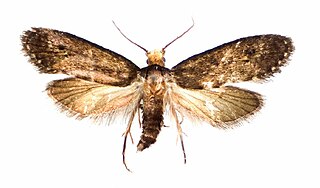
Pelecystola is a genus of moths belonging to the family Tineidae.

Nemapogon variatella is a moth of the family Tineidae. It is found in almost all of Europe. It is also found in North America.
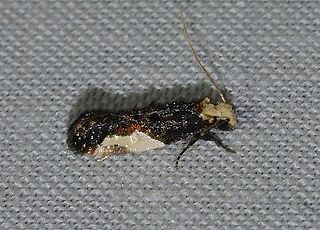
Monopis longella is a moth of the family Tineidae. It has been recorded from China, Korea India, Japan, Malaysia, Philippines, Russia and Thailand and is an introduced species in North America, where it has been recorded from New York to central Florida and west to Michigan.
Praeacedes is a monotypic moth genus in the family Tineidae first described by Hans Georg Amsel in 1954. Its only species, Praeacedes atomosella, was first described by Francis Walker in 1863. It has a wide range and has been recorded from Europe, Australia, Hawaii, India, Malaysia, Solomon Islands, Easter Island, Mauritius, Madagascar, Réunion, South America and North America. The species has commonly been misidentified in various parts of the world.
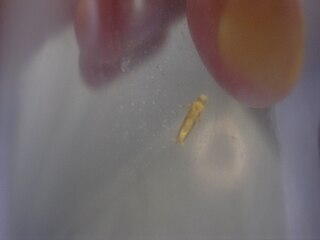
Erechthias minuscula, the erechthias clothes moth, is a moth of the family Tineidae. It was first described by Lord Walsingham in 1897. It is widespread and has been recorded from Africa, Sri Lanka, Java, Australia, the Caroline Islands, Fiji, Samoa, the Marquesas, the West Indies, Hawaii and Florida.

Monopis weaverella is a species of moth in the family Tineidae. It is found in most of Europe and North America.

Haplotinea insectella, the drab clothes moth or fungus grain moth, is a moth of the family Tineidae. It was described by Johan Christian Fabricius in 1794. It is found in all of Europe, except Ireland, the Iberian Peninsula and the western and southern part of the Balkan Peninsula. It is also found in North America. The species is often found in warehouses, granaries, mills and farm buildings.

Monopis spilotella is a moth of the family Tineidae. It was described by Johan Martin Jakob von Tengström in 1848. It is found in Scandinavia, Denmark, the Baltic region and Ukraine and Russia. It is also found in North America.
Nemapogon angulifasciella is a moth of the family Tineidae. It is found in North America, where it has been recorded from Alabama, Illinois, Indiana, Louisiana, Maine, Maryland, Massachusetts, Mississippi, North Carolina, South Carolina, Tennessee and West Virginia.

Nemapogon acapnopennella is a moth of the family Tineidae. It is found in North America, where it has been recorded from Arkansas, British Columbia, the District of Columbia, Florida, Illinois, Indiana, Maine, Maryland, Mississippi, Ohio, Oklahoma, Ontario, Quebec, South Carolina, Tennessee and Texas.
Nemapogon auropulvella is a moth of the family Tineidae. It is found in North America, where it has been recorded from Florida, Illinois, Indiana, Maine, Manitoba, Maryland, Minnesota, Ohio, Ontario, Quebec, Tennessee, West Virginia and Wisconsin.

Nemapogon clematella, the barred white clothes moth, is a moth of the family Tineidae. It is found in most of Europe and in North America, where it has been recorded from Maryland and North Carolina. The habitat consists of woodlands.

Philonome clemensella is a species of moth of the family Tineidae found in North America.
Agonopterix curvilineella, the curved-line agonopterix moth, is a moth in the family Depressariidae. It was described by William Beutenmüller in 1889. It is found in North America, where it has been recorded from Illinois, Indiana, Kentucky, Maine, Maryland, Massachusetts, Michigan, Minnesota, Mississippi, New Brunswick, New York, Ohio, Ontario, Quebec, Tennessee, West Virginia and Wisconsin.

Monopis dorsistrigella, the skunkback monopi, is a species of clothes moth in the family Tineidae.
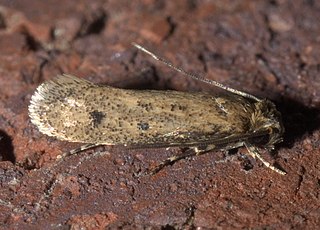
Niditinea orleansella is a species of clothes moth in the family Tineidae.
Pelecystola fraudulentella is a species of moth belonging to the family Tineidae.
